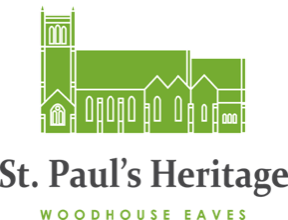
"Swithland Slate", Forest Stone" &
St Paul's Church
by Sue Young


(‘Forest’) Stone hole quarry 1894, St Paul’s above it
(reproduced by permission of British Geological Survey EA18/030)
In 1836 when St Paul’s was commissioned, the architect, William Railton, specified it was “to be built with the best materials of their respective kinds and finished in a substantial and workmanlike manner under the direction of Mr Railton”.
History of Swithland slate and ‘Forest’ stone use:
Swithland slate and ‘Forest’ stone have been an important local building materials, extracted from pits and outcrops of rock in multiple sites around Charnwood, over thousands of years. The terms describes stone, quarried until the 1880’s, from many sites including in Woodhouse Eaves, Swithland, The Brand and Groby.
Properties of Swithland slate:
Tough, lasting unchanged for hundreds of years
Few lichens can live on it
It can be beautifully, delicately and durably carved
It comes in glorious colours
It is very hard, very heavy and does not split as easily as Welsh slate.

The slate gravestone is better preserved.
Where is slate found in St Paul’s church and churchyard?
The roof, (as specified by Railton) Hand made Swithland roof slates were attached with wooden pegs or copper nails to form an overlapping roofing pattern with the smallest tiles at the top getting larger towards the bottom.
The walls – William Kirk, the first builder, was instructed that the main stone should be ….“Forest Stones which the said William Kirk shall be allowed to get and take from and out of the land adjoining the site of the said Chapel and the property of Ann Christiana Watkinson”.
The entrance doorsill is Swithland slate
Flooring under the nave carpet is Swithland slate
Swithland slate gravestones in the graveyards

Roof tiles exposed during recent repair works

Carved detail, Swithland slate gravestone, St Peter’s Church, Belgrave, Leicester

Walls of local ‘Forest stones’

St Paul's church